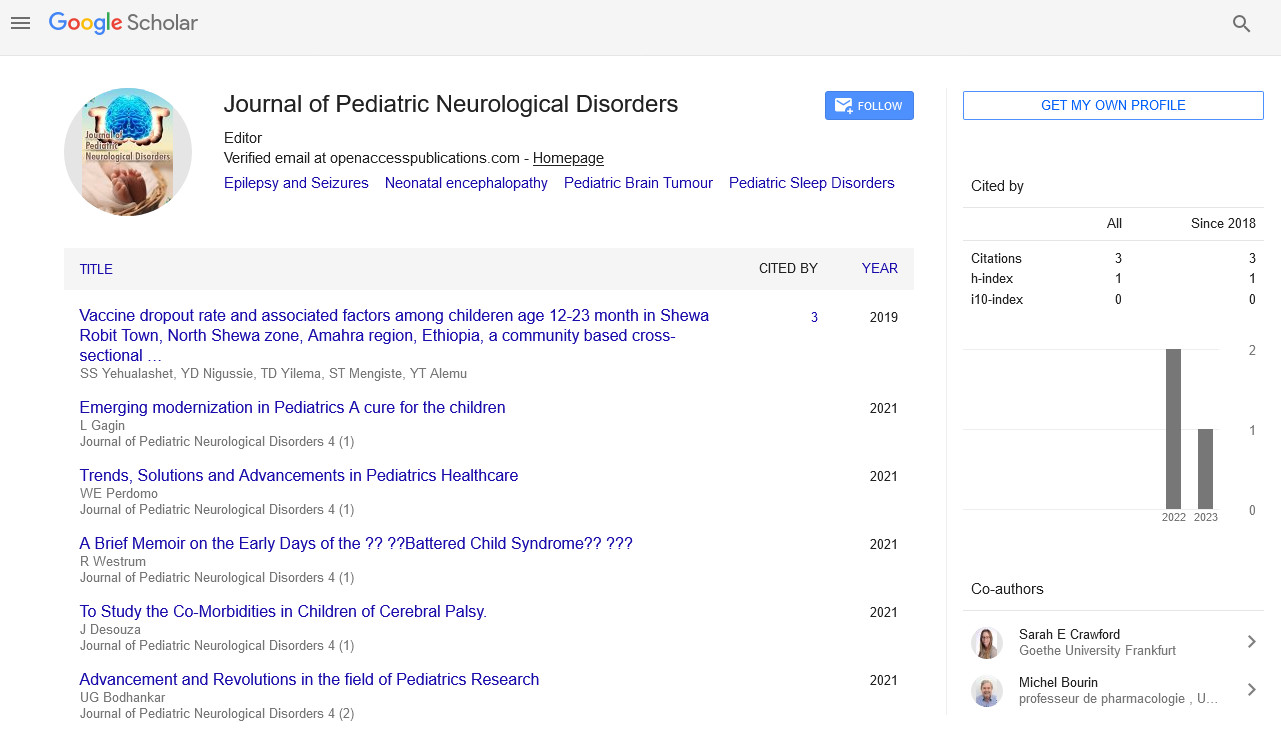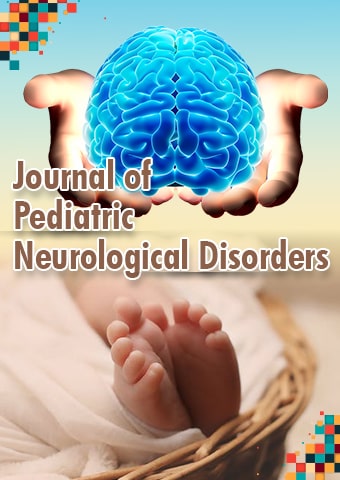Review Article - Journal of Pediatric Neurological Disorders (2023) Volume 6, Issue 4
Post-Traumatic Stress as a Psychological Reaction to Children's Mild Head Injuries
David Jackson*
Californian Institute of Neuroscience
Californian Institute of Neuroscience
E-mail: jacksondavid@cin.ac.org
Received: 01-Aug-2023, Manuscript No. pnn-23-111456; Editor assigned: 07-Aug-2023, PreQC No. pnn-23- 111456(PQ); Reviewed: 14- Aug- 2023, QC No. pnn-23-111456; Revised: 22-Apr-2023, Manuscript No. pnn-23-111456; Published: 31-Aug-2023, DOI: 10.37532/ pnn.2023.6(4).103-105
Abstract
Background
One of the most frequent pediatric emergencies is head trauma. The psychological repercussions of moderate head injuries are frequently disregarded, despite the fact that the psychological impacts of severe brain injuries are thoroughly researched. Mild head injuries include those with a Glasgow Coma Scale score of 13 to 15, headache, vomiting, a momentary loss of consciousness, temporary amnesia, and no focal neurological indications. The purpose of this study is to assess the early post-traumatic stress of children with modest brain injuries and their parents' pertinent perceptions.
Methods:
In this prospective cross-sectional study, parents and a cohort of kids with minor head injuries are included. The Child Trauma Screening Questionnaire (CTSQ), which was created by the kids, and the Children's Revised Impact of Event Scale (CRIES-13), which was created by the parents, were both used. Both questionnaires are trustworthy and commonly used. While the second is a weighted self-completed detecting instrument for the measurement of post-traumatic stress in children and adolescents, with a detailed evaluation of their reactions to the traumatic incident, the first exhibits excellent predictive ability in children with a risk of post-traumatic stress disorder. One week and one month following the upsetting occurrence, the individuals provided feedback.
Discussion
174 parents and 175 kids between the ages of 6 and 14 took part in the study. After one week, 33.7% of children had stress diagnosed, and 9.9% had it after one month. 19.0% and 3.9% of parental replies indicated that their kids might be stressed. These results demonstrated that minor head injuries are not always harmless. They are frequently undervalued by their parents and may cause the kids to experience psychological stress in the initial stages of the post-traumatic period.
Conclusion
Mild head traumas may have an impact on children's mental health. Healthcare professionals need to be aware of the significance of this often-overlooked type of injury's psychological impact. They should be knowledgeable about the psychological effects of trauma, be alert to the possibility, swiftly inform the parents, and offer psychological support in addition to medical care. To reduce the likelihood of developing post-traumatic stress disorder in the future, support and follow-up are required. The results of this study only applied to a small group in terms of numbers, ages, and survey duration; therefore, more in-depth research is required. Furthermore, many kids with minor head injuries choose to remain at home and go unreported rather than visiting the emergency room.
Keywords
Pediatric emergencies • Psychological repercussions • Temporary amnesia • Post-traumatic stress • Traumatic incident • Psychological stress
Introduction
An explosion of evidence is what distinguishes advancements in pediatric trauma diagnosis and therapy. The management of children in emergency rooms is greatly impacted by the interpretation of data from the evolution of important emergency procedures, such as cardiopulmonary resuscitation and transfusion updates. Nevertheless, despite the significant advancement, injuries sustained in infancy and adolescents continue to be the leading reason for hospitalization globally. Traumatic brain injury is a significant source of morbidity and mortality as well as a frequent reason for pediatric emergency department admissions each year. It is recognized as the primary cause of mortality and morbidity in children and adolescents. More than half of all pediatric fatalities occur in wealthy nations due to trauma. In the United States of America, major brain injuries affect 37,200 kids annually. Estimates place the annual incidence of pediatric brain trauma at 475,000. The Glasgow Coma Scale (GCS) score for the majority of traumatic brain injuries (80–90%) ranges from 13–15 [1].
The psychological damage and dysregulation of mental health following severe head traumas are well documented. Post-Traumatic Stress Disorder (PTSD) is a lifelong effect that has been thoroughly researched. Following exposure to a terrifying or upsetting event or sequence of events, PTSD may manifest. Reliving terrible events in the present through vivid intrusive memories, flashbacks, or nightmares is what makes it distinctive. Additionally, it is characterised by avoiding things or persons who remind one of the occurrence, as well as thoughts and memories of the event. Last but not least, there is a steadfast impression of an intensified present threat, which may be manifested as hyper vigilance or a heightened startle response to stimuli like sudden noises [2, 3].
Methods
This prospective cross-sectional cohort study investigated the stress experienced by children after minor head injuries and the pertinent perspective of their parents. The World Health Organization defines stress as a feeling of anxiety or tension brought on by a challenging circumstance. There are several other emotions present, including irritation and anxiousness. Ages 6 to 14 years, fluency in the Greek language, the absence of neurodevelopmental disorders, the absence of recent divorce or a death in the family, a history of medications, the exclusion of abuse, the hospital stay following the traumatic event being no longer than 24 hours, written parental consent, and child assent were the inclusion criteria for study participation [4].
In order to concentrate on the traumatic incident as the only probable reason of disarray, it was decided to choose kids who did not exhibit any other potential sources of stress at the time of their visit to the emergency room. Greek fluency was deemed necessary for achieving the best understanding of the questions and avoiding misleading answers [5].
The family was introduced to and given information about the survey by P.K., a member of the research team who worked in the emergency room. Random sampling was used. He made contact right away if he was there when the patient was admitted [6].
If not, he met the youngster and the accompanying parent during their brief hospital stay and had a conversation with them. He gave them the questionnaires and a description of the study's objectives before instructing them to fill them out and return them between one week and one month after the traumatic event. The poll was agreed to by both parents and kids, who were also informed that they could voluntarily opt out at any time. A consent form was obtained at that time, and demographic and clinical data were noted. The same researcher maintained touch with the families throughout the post-traumatic period, either in person or by phone calls [7].
Discussion
In this study, we looked at a cohort of kids who had mild head injuries to see if there were any psychological effects and what their parents thought about it. One week after the traumatic event, it was discovered that 33.7% of the kids experienced stress, although only 19.0% of their parents thought their kids had stress. One month later, things seemed to be getting better, although stress was still present in 9.9% of children, compared to only 3.9% of parents who reported it. These findings may point to a potential future risk of PTSD occurrence. The findings suggest that mild head trauma, the most frequent type of head trauma, may not be as innocent for all kids. The results of similar research provide evidence of psychological effects following minor head trauma [8]. When these symptoms last more than a month after the stressful event, they are sometimes characterised as PTSD or postconcussion syndrome. 20% of kids with mild traumatic brain injuries are said to exhibit severe cognitive, physical, and psychosocial problem. In a recent investigation, normal computed tomography and electroencephalogram revealed epilepsy in children with mild traumatic head injuries, loss of consciousness, or amnesia lasting less than 30 minutes.
In 12-30% of children, these symptoms may last longer than one month, and in some cases, more than a year [9]. After a brain injury, stress symptoms were reported by 16% of children two weeks later, 10-12% of children one month later, and 6% of children three months later. According to a study on a group of kids who had been in vehicle accidents and suffered various degrees of traumatic brain injury, 38% of them got PTSD after one month and 15% after six. A meta-analysis of 72 papers found that 16% of children and adolescents who received PTSD treatment actually recovered [10f].
Conclusion
The results of the study demonstrated that even minor head traumas can result in enduring psychological effects. 33.7% of kids showed signs of stress in the early post-traumatic period, but by the end of the first month, that number had dropped to 9.9%. In 19.0% of cases after the first week and in 3.9% of cases after one month, their parents expressed a perception of their stress. This belief was false for 23.4% of parents who thought their child did not experience stress while they did, and for 24.2% of parents who thought their child did experience stress while they did not. Additionally, we discovered that parental symptoms of anxiety and sadness had an impact on the presence of stress and how the parents were seen.
References
- Cavallaro S, Easter J. Updates in pediatric emergency medicine for 2022. Am J Emerg Med. 68, 73-83 (2023).
- Kiragu AW, Dunlop SJ, Wachira BW et al. Pediatric trauma care in low- and middle-income countries: A brief review of the current state and recommendations for management and a way forward. J Pediatr Intensive Care. 6, 52-59 (2017).
- Fischer J, Mathieson C. The history of the Glasgow Coma Scale: Implications for practice. Crit Care Nurs Q. 23, 52-58 (2001).
- Warren AM, Boals A, Elliott TR et al. Mild traumatic brain injury increases risk for the development of posttraumatic stress disorder. J Trauma Acute Care Surg. 79, 1062-1066 (2015).
- Smith P, Perrin S, Dyregrov A et al. Principal components analysis of the impact of event scale with children in war. Pers Individ Dif. 34, 315-322 (2003).
- Donlon K, Jones RT. Applying a traumatic stress approach to understanding PCS following pediatric mild TBI. Child Neuropsychol. 21, 803-822 (2015).
- Truss K, Godfrey C, Takagi M et al. Trajectories and risk factors for post-traumatic stress symptoms following pediatric concussion. J Neurotrauma. 34, 2272-2279 (2017).
- Alisic E, Zalta AK, Larsen SE et al. Rates of post-traumatic stress disorder in trauma-exposed children and adolescents: Meta-analysis. Br J Psychiatry. 204, 335-340 (2014).
- McNally KA, Bangert B, Dietrich A et al. Injury versus noninjury factors as predictors of postconcussive symptoms following mild traumatic brain injury in children. Neuropsychology. 27, 1-12 (2013).
- Kirkwood MW, Kirk JW, Blaha RZ et al. Noncredible effort during pediatric neuropsychological exam: A case series and literature review. Child Neuropsychol. 16, 604-618.
Indexed at, Crossref, Google Scholar
Indexed at, Crossref, Google Scholar
Indexed at, Crossref, Google Scholar
Indexed at, Crossref, Google Scholar
Indexed at, Crossref, Google Scholar
Indexed at, Crossref, Google Scholar
Indexed at, Crossref, Google Scholar
Indexed at, Crossref, Google Scholar

